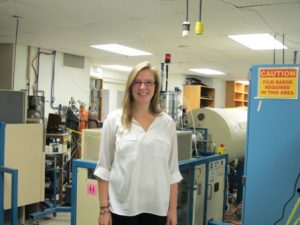Differential PIXE Analysis of Multi-layer Auto Paint
Research Advisor: Dr. Paul DeYoung and Dr. Graham Peaslee
Differential Particle Induced X-ray Emission (DPIXE) is a technique developed to analyze multi-layered samples in a non-destructive manner. Analysis of auto paint, in particular, is beneficial in legal cases involving automobile crimes. Particle Induced X-ray Emission (PIXE) involves particle beams produced by an ion beam accelerator to analyze the concentration of elements present in one or more layers. As the beam penetrates into the sample, characteristic x rays of various energies are emitted which correspond to different elements in the sample. DPIXE involves varying the beam energy so the beam penetrates to different depths within the sample, emitting x rays only from the layers through which the beam has passed. Quantitative analysis is made easier by first taking measurements of the thickness of each layer. A Scanning Electron Microscope (SEM) with Energy Dispersive Spectroscopy (EDS) capabilities allows us to view a cross-section of paint and measure the thickness of each layer, as well as earn a better understanding of which layers hold the major elements within the sample. A careful combination of the SEM, EDS and DPIXE data is required to obtain accurate concentrations of elements in a sophisticated peak fitting program (GeoPIXE) with calculations of energy loss as the beam penetrates to different depths and reabsorption of x rays as they travel out of the sample towards the detector. This technique has shown to produce reasonable results when analyzing samples containing layers of uniform thickness.
his effort is based upon work supported by the National Science Foundation under grant No. PHY-1306074.


